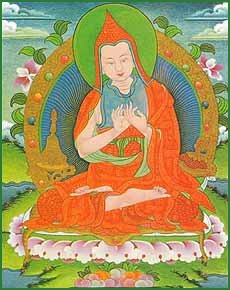The Great Chariot
by Longchenpa | 268,580 words
A Commentary on Great Perfection: The Nature of Mind, Easer of Weariness In Sanskrit the title is ‘Mahāsandhi-cittā-visranta-vṛtti-mahāratha-nāma’. In Tibetan ‘rDzogs pa chen po sems nyid ngal gso’i shing rta chen po shes bya ba ’...
Part 1b.1c - The occasion of awareness
Now the occasion of awareness is taught:
When awareness is undistracted, being without all thoughts,
One-pointed, without the grasping of apparent objects,
That is the time of apprehension of alaya.Not entering into fixation of luminous appearance
Is the motionless, clear, and luminous alaya-consciousness.When the five objects are grasped and fixated, affirmed and denied,
And objects are coarsely conceived in the seven consciousnesses,
That is what is called the seven consciousnesses.
Unwavering one-pointedness with no thoughts at all is the occasion of alaya. When apparent objects are seen lucidly, with still attention and no conceptualization at all, that is alayavijñana. Then, when phenomenal objects arise clearly and distinctly that is awareness of the five gates. When any object that arises is grasped at the first instant, then in the second mixed with analysis, thereby producing kleshas, this fixated arising is the occasion of klesha mind and the mental consciousness.
Those are the seven consciousnesses.
The Bodhisattva Levels says:
Non-thought unconnected to objects is the occasion of alaya. Non-thought connected to objects is the occasion of alayavijñana. Individual apprehension of phenomenal objects is the five gates. With subsequent analysis of the first conception of objects, grasping and fixation arises. This becomes mind-consciousness and the occasion of klesha-mind.
